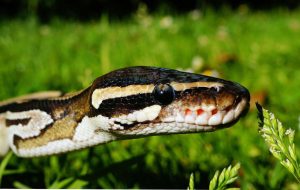Ball python spotted slithering around Kananaskis Country
By Jessica Lee, Local Journalism Initiative Reporter
A wayward reptile native to Sub-Saharan Africa is slithering around Bow Valley Provincial Park in Kananaskis Country.
The Bow Valley dump station sees a lot of visitors during the busy summer tourist season, but a ball python spotted on site Sunday (July 21) may be its most unexpected to-date.
Alberta Parks issued a wildlife warning for Bow Valley Provincial Park, Bow Valley Campground and Willow Rock Campground, after the snake – commonly kept as a pet and reaching a maximum six feet in length – was observed by Alberta Parks staff at the dump station Sunday morning.
“The snake is believed to be a 1.5-metre long ball python, which is native to Africa. Ball pythons are not venomous, but they can pose a threat to local wildlife and small pets,” said Pam Davidson, forestry and parks press secretary, in a statement.
“Invasive species like this threaten Alberta’s ecosystems and biodiversity.”
Sheri Monk, owner of Snakes on a Plain – a company based out of Redcliff, Alta. and licensed by the Alberta government to handle and relocate native snake species, said her initial reaction to hearing about the reptile warning was laughter.
“In an area that we have to learn how to hike safely around bear activity, for there to be a warning about a ball python is interesting because they are really known as sluggish snakes that don’t move around a lot,” she said.
Monk noted that while introducing an invasive species is not an issue to be taken lightly anywhere it occurs, the biggest threat the non-venomous ball python poses is to rodents and it is unlikely to survive long in this environment.
“We definitely don’t have to worry about any danger to the public and this snake is not going to be taking down a deer or coyote, or any other common larger wildlife that we might encounter in K-Country,” she said.
Monk, who has studied rattlesnakes since 2005 and has travelled extensively to study venomous snakes on three continents, speculates the reptile was likely someone’s pet, left behind by its owner.
“My other reaction was sadness,” she said. “This is sort of a refuse dump station and it sounds like somebody’s just dumped their pet, which doesn’t reflect well for pet owners in general, but also reptile keepers, specifically.
“Areas like Florida, for example, really struggle with pet dumping and it’s a huge issue in terms of threat to the natural ecosystem.”
The snake poses less of a threat in the wilds of the eastern slopes of the Alberta Rockies, however, where it would not survive winter.
“Even in the off chance that this was a female pregnant ball python, and even if she did reproduce in the wild, those snakes are not going to survive our winter. So, we don’t have to worry about a population of ball pythons becoming established in Alberta.”
There is also no hybridization opportunity for the reptile to breed with other species, like the red-sided garter snake, which can be found in cooler temperatures in the province, such as the Bow Valley. The two species, Monk noted, are too genetically different to breed successfully.
Monk said ball pythons kept in captivity are also known to sometimes be picky eaters and it is a misconception that all reptiles like or need hot weather to survive, like what the Bow Valley and much of Alberta have been experiencing under ongoing heat warnings.
Reptiles are cold-blooded, meaning they do not have the ability to regulate body temperature.
“Normally, our native snakes, when it gets too hot – let’s say in the high 20s [Celsius] – they’re often going to find shade or a gopher hole to scramble down because otherwise they could overheat and die,” said Monk.
“They need to monitor their own body temperature by using the environment for both heating and cooling, so, there’s a good chance this ball python could already be dead thrust into this new environment, particularly in this heat wave.
“It’s just sad for the snake.”
Monk encouraged anyone keeping an animal as a pet – in the same way you should not dump a cat or a dog – to take responsibility for it.
“That’s cruel to the animal, and certainly in some cases, it can be very ecologically irresponsible.”
While ball pythons are non-native to Alberta, there are seven snake species that are native to the province, with most more commonly found in the southeastern portion.
“We do have venomous prairie rattlesnakes,” said Monk, who also listed off three species of garter snakes, bull snakes, plains hognose snakes and the eastern yellow-bellied racer.
“Alberta may be known for its grizzly bears and big wildlife like that, but we’re a very diverse province and I would encourage everybody to appreciate our native reptiles and amphibians.”
Any sightings of the wayward snake should be reported to Kananaskis Emergency Services at 403-591-7755.

